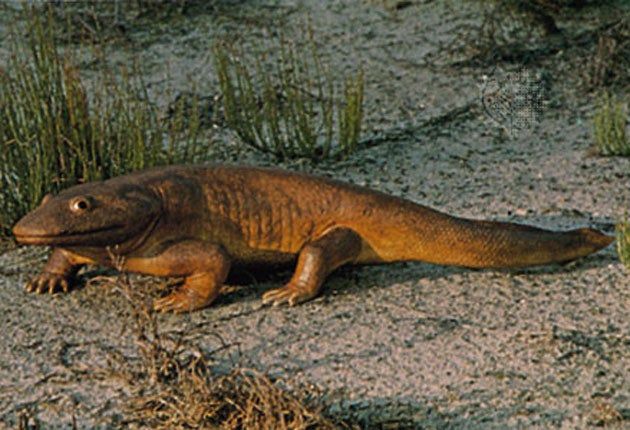When fish took their first steps on land...
Footprints dating back 395 million years shed light on evolutionary milestone

Your support helps us to tell the story
From reproductive rights to climate change to Big Tech, The Independent is on the ground when the story is developing. Whether it's investigating the financials of Elon Musk's pro-Trump PAC or producing our latest documentary, 'The A Word', which shines a light on the American women fighting for reproductive rights, we know how important it is to parse out the facts from the messaging.
At such a critical moment in US history, we need reporters on the ground. Your donation allows us to keep sending journalists to speak to both sides of the story.
The Independent is trusted by Americans across the entire political spectrum. And unlike many other quality news outlets, we choose not to lock Americans out of our reporting and analysis with paywalls. We believe quality journalism should be available to everyone, paid for by those who can afford it.
Your support makes all the difference.The fossilised tracks of one of the first four-legged creatures to walk on land have been discovered in a disused quarry in southern Poland. The footprints date back 395 million years and are about 18 million years older than the oldest known "tetrapod" fossil.
Scientists said that the discovery of the fossilised trackways sheds new light on one of the most important transitions in evolution: the point when fish with gills became air-breathing, terrestrial animals that walked on four legs.
The researchers have found several kinds of tracks made by animals of different sizes as they walked across the muddy floor of a marine lagoon, as well as individual footprints, some as large as 26cm wide, indicating a four-legged creature about 2.5m long.
According to a report in the journal Nature, the tracks have distinctive "hand" and "foot" prints and are arranged in a diagonal sequence with no evidence of the body being dragged along the ground, showing that the animal walked by flexing its raised body much like a modern-day lizard.
The tracks were found at the disused Zachelmie quarry in the Lysogory region of the Holy Cross Mountains in south-eastern Poland. They occurred in a rock formation several metres beneath a younger rock formation.
"The age is much earlier than any known tetrapods and the living environment is surprising – the fish-tetrapod transition was mostly supposed to take place in freshwater ponds or rivers or in coastal vegetated areas. And here we have a marginal marine, lagoonal or tidal, rather non-vegetated environment," said Marek Narkiewicz of the Polish Geological Institute. The trackways were first discovered in 2004 but were thought to belong to dinosaurs, which lived millions of years later. "It appeared so improbable that until 2007 nothing happened," Professor Narkiewicz said. With his wife, he worked out a more precise age for the rock formation using microscopic fossils, which suggested the trackways were made 395 million years ago, in the middle of the Devonian Period.
Some of the tracks are so detailed that they still have the imprints of toe-like digits. The diagonal stride of the footprints indicates that they could not have been made by the fins of a fish or indeed any other animals known to be living at the time, the scientists said.
"[The tracks] were made in the mud of a shallow marine lagoon, but no known coeval animal other than an elusive tetrapod could have left such imprints," said Philippe Janvier of the French National Natural History Museum in Paris.
"They show that the first tetrapods thrived in the sea, trampling the mud of coral-reef lagoons. This is at odds with the long-held view that river deltas and lakes were the necessary environments during vertebrate evolution," Dr Janvier said.
Join our commenting forum
Join thought-provoking conversations, follow other Independent readers and see their replies
Comments